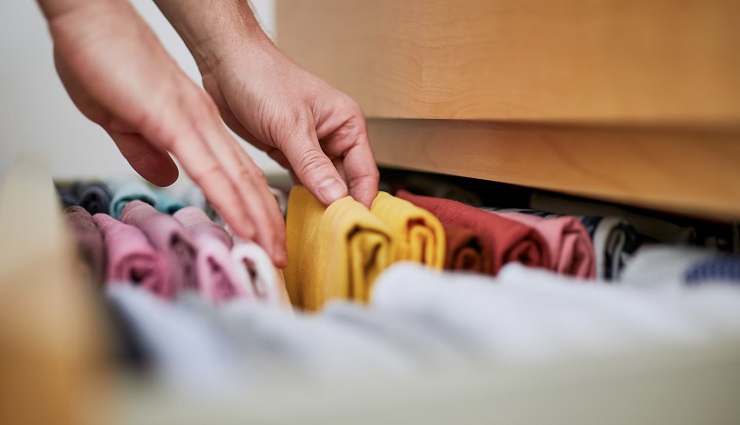Philodendrons is one of the beautiful houseplants that have many species. The leaves of this plant are usually large, green, and shiny. Philodendrons grow fast, and this feature is the reason for the incredible popularity of this beautiful houseplant. In addition to its beauty and fast growth, Philodendron is an excellent choice for purifying the air in your home. You will read everything you need to know about this beautiful plant in this article. Stay with us.
Philodendron types
Philodendron has many species. In this section, we introduce some of its famous varieties.
1. Philodendron heart leaf
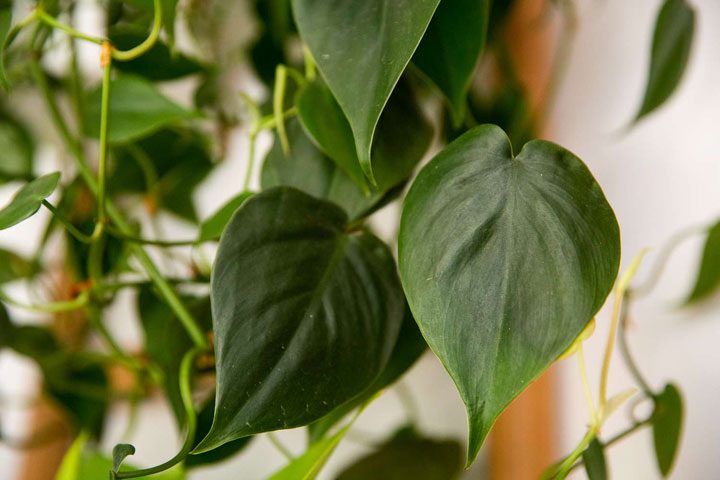
Green Philodendron is the most popular and classic species of this plant. The heart-shaped leaves of this plant have caused some people to confuse it with pets. This type of Philodendron loves very humid places like the bathroom. The preferred light of this plant is also low light, which makes it suitable for corridors and darker rooms.
2. Miniature Philodendron (Xanadu)
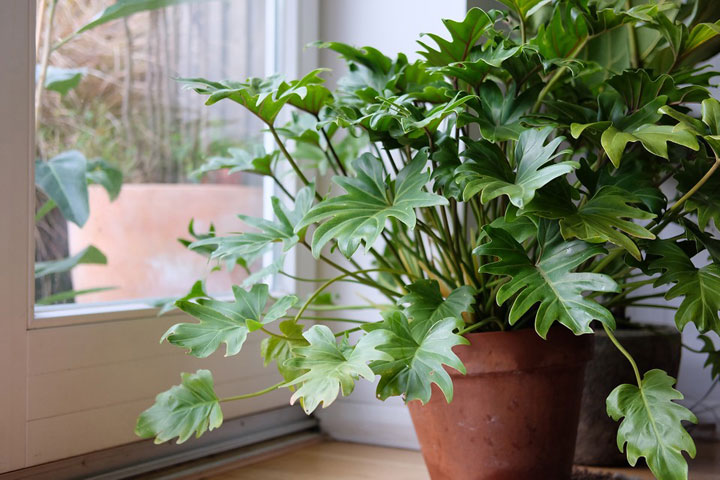
This plant has dark green and split leaves. Each leaf grows on a solid and long stem. This type of Philodendron is suitable for use in the corner of the room.
3. Orange philodendron

This type of Philodendron is a plant with beautiful and eye-catching colors. The leaves of this plant are broad and spear-shaped and grow vertically on short stems.
4. Pink Princess Philodendron
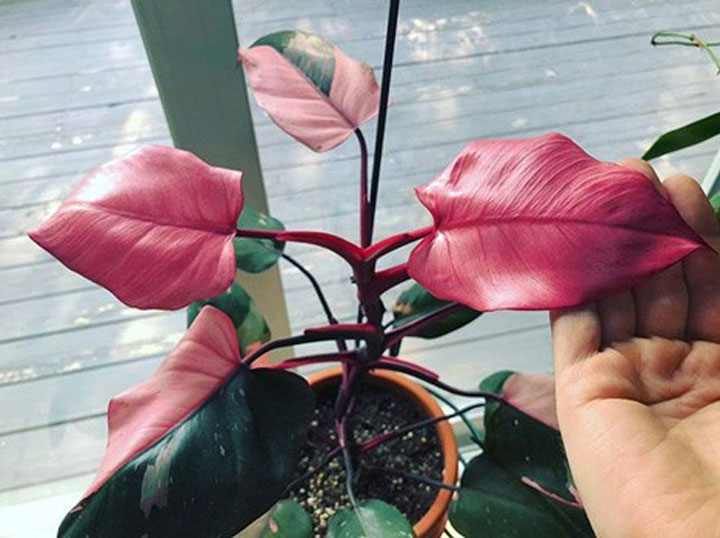
The pink princess philodendron has a romantic and attractive appearance. The color of the plant’s leaves, which have a spectrum of pink and green, is the main reason for its attractiveness. Pink Princess is a creeper. However, many people like to cut it back into a shrub. This flower is not suitable for open spaces.
5. Philodendron Rojo
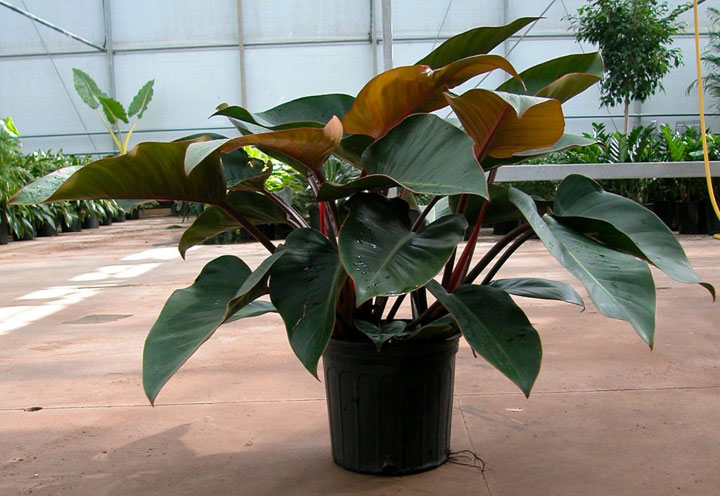
The beautiful colors of the leaves of this plant will surprise you. Rojo is a grafted plant that stays small and manageable. The leaves of this plant are oval, long and shiny, grow vertically, and form beautiful shrubs. This type of Philodendron is suitable for a modern and artistic room.
6. Philodendron fig leaf
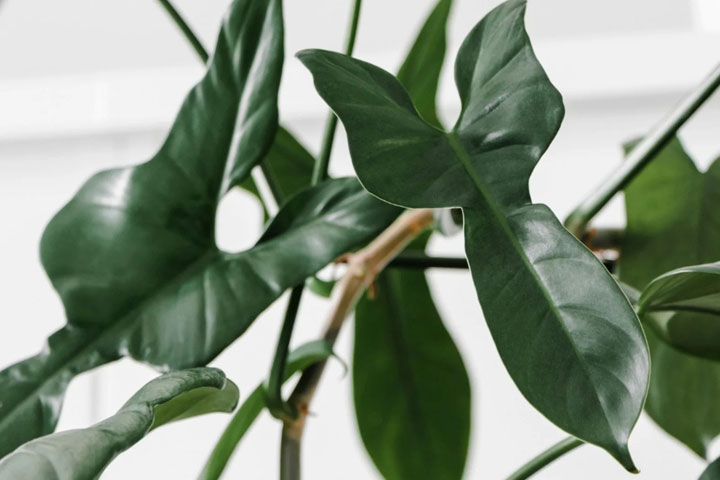
This species has broad leaves with long slits. The fig-leaf philodendron needs moist, humus-rich soil, a large container for growing roots and wood, or firm support for its thick trunk.
7. Philodendron Black
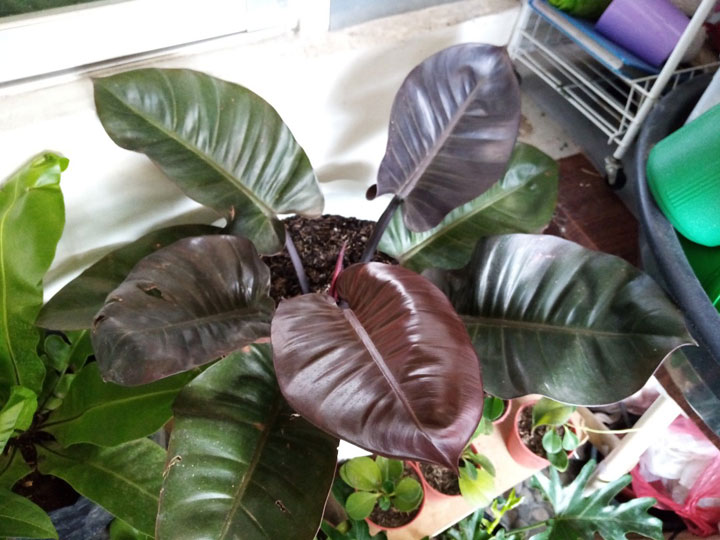
The length of this species is about 1 meter, and the width is about half a meter. The foliage of this plant has a bronze or wine color at first, which gradually changes to dark green and black.
8. Philodendron new
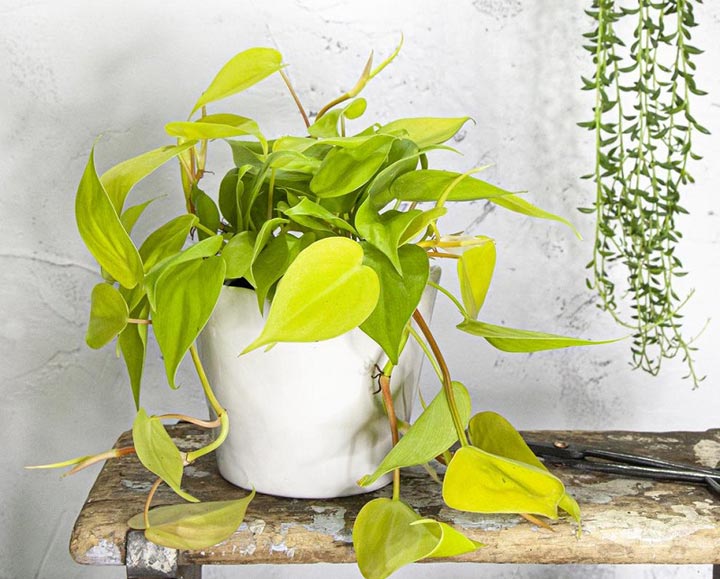
This type of Philodendron is a light green climbing plant. This plant is the same color throughout the year, making it attractive and popular. Neon philodendron performs best in soft indirect light, a temperature range of 18.3 to 26.6 degrees Celsius, humidity over 60%, moist soil with good drainage, and constant pruning.
9. Philodendron gloriosum
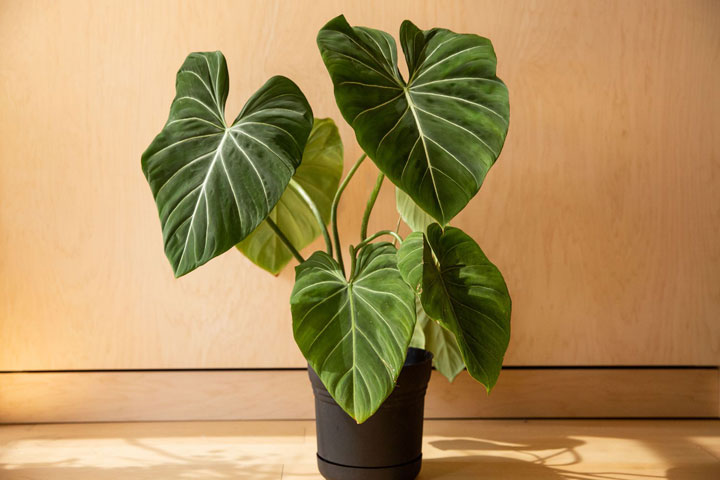
This plant grows vertically and has large green leaves with white veins. Perhaps the most apparent feature of this plant is the size of its leaves. The length of the leaves may reach 60 cm! This plant can decorate an ample living room or office space.
10. Philodendron Birkin

This plant has thin white stripes on its green leaves. Berkin is a compact plant; it grows almost slowly and is nearly easy to care for.
Philodendron care
Maintaining the right conditions for the plant to be healthy is very important. In hot weather, place the Philodendron in a shady place to get fresh air and natural light. Beware of direct sunlight, as it may burn the delicate leaves.
Clean the leaves of the plant regularly with a damp cloth. This plant has no serious pest or disease problems but may be sensitive to common houseplant pests, including aphids, mealybugs, scales, thrips, and spider mites. Kill pests with natural insecticidal soap or horticultural oil.
1. others
Philodendron grows well in low light. Philodendrons need sun, but it’s best to receive soft light under a shade instead of direct sunlight. The best place to place this flower inside the house is next to the window so that it gets soft and indirect light. Too much light causes the yellowing of many plants’ leaves simultaneously.
2. Soil
The ideal potting soil for philodendrons is rich in organic matter with good drainage. These plants are sensitive to the salts that accumulate in the ground during irrigation. These salts may cause the leaves to turn brown or yellow. It is recommended to change the Philodendron soil every few years.
3. Water
These plants usually like soil with medium moisture. Check the ground to determine how often to water your Philodendron per day. Water the plant when the soil surface is dry. Both excessive watering and lack of water cause the plant’s leaves to drop. Also, excessive watering can cause the roots of the plant to rot. Another critical point is that houseplants need less watering during the winter.
4. Temperature and humidity
The appropriate temperature varies according to the plant species. Philodendrons should not be exposed to a temperature lower than 12.5 degrees Celsius. Do not expose the plant to direct, calm wind, like an air conditioner. These plants love humidity, so if you live in a dry climate, you may have to increase the humidity around the plant. To do this, you can spray water on the plant’s leaves every few days. You can also place the pot on a tray filled with pebbles to ensure that the bottom of the bank does not touch the water.
5. Fertilizer
Give Philodendron liquid fertilizer every month in spring and summer. Read product label directions for information on how much fertilizer to apply. In autumn and winter, reduce feeding with fertilizer to every 6 to 8 weeks. If your plant is not getting enough nutrients, it will grow slower than usual, and its leaves may be smaller than usual.
6. Soil pH
The ideal pH for Philodendron is 6.5 to 7.5.
7. prune
If your philodendron flower has grown too tall, prune it using sterilized pruning shears. You can safely prune this plant at any time of the year, but the best time to do so is spring or summer. Take stem cuttings and use them to propagate the plant.
Philodendron cuttings
The best time to take philodendron cuttings is early spring, as the days get longer. To cut a plant, you need to cut a part of the stem and place it in a container of water so that its roots grow. After root growth, place the cutting in moist soil.
Planting Philodendron seeds
The seed planting method is slower than cuttings and takes longer for the plant to grow. The seeds of this plant do not need to be soaked before planting.
- You can plant several seeds in a 15 cm pot. Sow one seed every 5 cm at a depth of 8 cm.
- Cover the plant with plastic. Remove the plastic from time to time to let air in.
- Spray water regularly on the soil to keep it moist.
- It takes about 2 to 8 weeks for the seeds to germinate at a temperature between 20 and 23 degrees Celsius.
- Transfer each one to a small pot when the seedlings have sprouted and are strong enough.
Planting philodendron flowers in a new pot
When the philodendron roots come out of the soil and out of the pot’s drainage holes, it’s time to repot the plant. The ideal time to replant is late spring or early summer. Choose a bigger pool to replant the plant. Gently remove the plant from the old pot, place it in a new pot with fresh soil, and then water it.
Common Philodendron Problems
Philodendrons are plants that quickly get used to living indoors. Of course, when the conditions are not suitable for plant growth, it may have some problems. We present the most common issues of Philodendrons below.
1. Yellowing of leaves
The cause of yellowing leaves is different problems such as watering with too cold water or lack of light. If the older leaves turn yellow, it may be a sign that you are under-watering the plant. If the younger leaves turn yellow, it may be a sign of overwatering the plant. The plant will soon return to its original state by providing suitable environmental conditions.
If you want to fertilize the plant, water the soil, add the diluted fertilizer solution with water, and finally, water the plant again. These additional steps prevent the chemicals in the fertilizer from burning the roots and preventing the leaves from turning yellow.
2. The smell of root rot
If the leaves of your plant turn yellow very quickly, it may be a sign of root rot. You can smell the soil to check for the breakdown; If it is rotten, it will smell unpleasant. You can also shake off the ground and check the roots. Remove the black parts of the rotten roots and plant the white or yellow parts of the seeds in a clean container with fresh soil.
3. Browning of leaves
If the edges of the leaves of the plant have turned brown, you probably watered the plant with cold water, and it was shocked. Brown leaf edges are a twisted sign that the plant needs more water and less sun. The browning of the tips of the leaves with yellow halos also shows that the plant needs more moisture.
The difference between pets and Philodendrons
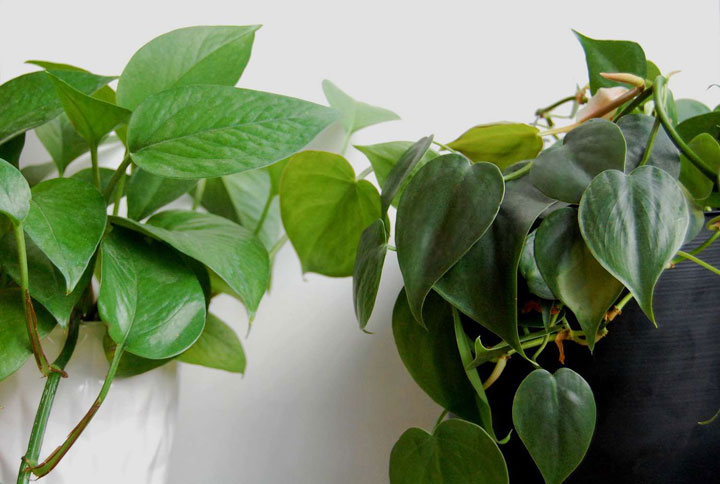
- Leaves: One of the easiest ways to tell Pothos and Philodendrons apart is by their leaves. Petus leaves are thicker than Philodendrons.
- Aerial roots: Petus have only one sizeable aerial source per node, while philodendrons may have several smaller aerial cores per node.
- Petioles: Petioles are tiny stems that attach the leaves to the main branches of the plant. The petioles of philodendrons are thinner than petioles.
- Environmental conditions: While pets and Philodendrons can tolerate low light, philodendrons accept low light more efficiently than pets. Also, pets are more drought resistant than Philodendrons.
Common questions about philodendrons
– Is it easy to take care of Philodendron?
Yes. Easy plant care makes Philodendron a suitable plant for beginners. Philodendrons are famous for their attractive appearance and minimal care requirements.
– How does Philodendron grow?
This plant is fast growing, up to 10 cm per week during spring and summer.
How long does a philodendron live?
If the conditions are right, this plant can remain vigorous and green for several decades.
– How much is the price of a philodendron plant?
The price of this beautiful flower depends on its type and size.
you say
Are you one of those who are interested in all kinds of flowers and plants? Please share your valuable comments and experiences about Philodendron with our dear users and us.

